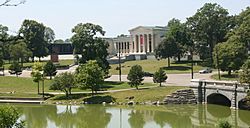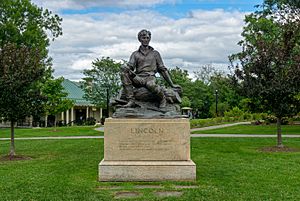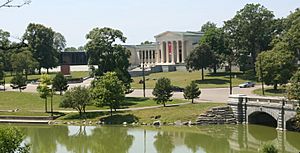Delaware Park–Front Park System facts for kids
Quick facts for kids |
|
|
Delaware Park–Front Park System
|
|

Hoyt Lake in Delaware Park, with the Albright-Knox Art Gallery.
|
|
| Location | Front Park, Porter Ave. to Symphony Cir., N along Richmond Ave., Bidwell Pkwy., Gates Cir. and Delaware Park, Buffalo, New York |
|---|---|
| Area | 505.9 acres (204.7 ha) |
| Architect | Olmsted, Frederick Law; Vaux, Calvert |
| MPS | Olmsted Parks and Parkways TR |
| NRHP reference No. | 82005029 |
| Added to NRHP | March 30, 1982 |
The Delaware Park–Front Park System is a famous group of parks and parkways in Buffalo, New York. It's considered a "historic district" because it's an important area with a lot of history. This amazing park system was designed by two very talented landscape architects, Frederick Law Olmsted and Calvert Vaux. They worked on it between 1868 and 1876.
This park system was officially added to the National Register of Historic Places in 1982. This means it's recognized as a special place worth protecting.
Contents
Exploring the Park System
The Delaware Park–Front Park System includes several cool areas. Let's take a look at some of them:
Delaware Park: The Main Attraction
Delaware Park is the biggest and most central part of the system. It's located in the North Buffalo area. This huge park, about 376 acres, was first called "The Park" by its designers. Later, it was renamed Delaware Park because it's close to Delaware Avenue, which used to be known for its big mansions.
The park is split into two main parts:
- The "Meadow Park" on the east side, which is a large open grassy area.
- The "Water Park" on the west side, which features Hoyt Lake. This lake was originally called "Gala Water" and was a big part of the Pan-American Exposition in 1901.
A highway called the Scajaquada Expressway goes through the park.
Fun Things to Do in Delaware Park
Delaware Park is home to many exciting places:
- The Albright–Knox Art Gallery is on the park's western edge, right by Hoyt Lake. It's a great place to see art!
- The Buffalo History Museum is on the northern side, overlooking Scajaquada Creek. You can learn a lot about Buffalo's past here.
- Every summer, the park hosts Shakespeare in Delaware Park. This is a free outdoor festival where you can watch plays by William Shakespeare. It's one of the largest free Shakespeare festivals in the United States!
- The Buffalo Zoo is also located in Delaware Park, on the east side of the Meadow Park. You can visit many animals from all over the world here.
- The park also has a golf course, baseball fields, tennis courts, and soccer fields. It's a perfect spot for sports and outdoor activities.
The Famous David Statue
Delaware Park has a special replica of Michelangelo's famous David statue. This copy was put in the park in 1903. It's one of the few copies made directly from the original statue. When it was first put up, it had a fig leaf, which the original statue does not. In 2013, the statue got a new plaque that correctly spelled the artist's name as Michelangelo.
Connecting Parks and Parkways
The Delaware Park–Front Park System isn't just one park. It's a network of parks and wide, tree-lined streets called parkways. These parkways connect the different parts of the system.
- Gates Circle is a round area with a large sunken fountain built in 1904.
- Chapin Parkway connects Gates Circle to Soldier's Place.
- Soldier's Place is another large circle. You can see the William R. Heath House (built in 1904 by Frank Lloyd Wright) from here.
- Lincoln Parkway connects Soldier's Place to Delaware Park.
- Bidwell Parkway connects Colonial Circle to Soldier's Place. It features a large bronze sculpture called Birds in Flight by Larry Griffiths.
- Colonial Circle has an equestrian (horseback riding) statue of General Daniel D. Bidwell.
- Richmond Avenue connects Symphony Circle to Colonial Circle.
- Ferry Circle is a round intersection.
- Symphony Circle is a large circle where several streets meet. The Kleinhans Music Hall, a very important building, is located here.
- Porter Avenue connects Symphony Circle to Columbus Park and Front Park.
- Columbus Park is near D'Youville College and has a public library branch.
- Front Park is a park right at the start of the Niagara River, overlooking Lake Erie. It's home to the U.S. entrance to the Peace Bridge, which was built in 1927. The park also has baseball fields, open areas, and tennis courts. There's a monument to Commodore Oliver Hazard Perry here too.
See also





